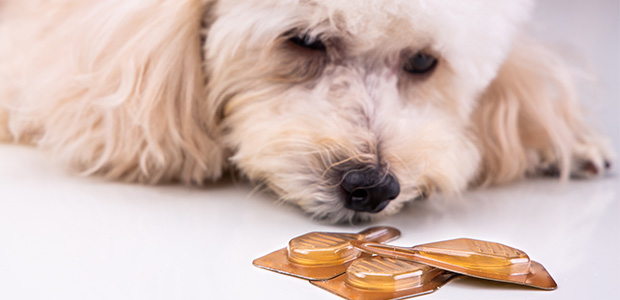Are essential oils safe for dogs?
First Published: 19/12/2019
Last Updated: 17/10/2023
In recent years, many owners have taken a more holistic approach to their dog’s healthcare. This has led to an increase in the use of essential oils.
Essential oils do have their benefits, but they can be risky for our furry friends too.
Let’s take a closer look at what exactly essential oils are, which of them are toxic and how to use essential oils responsibly.
What are essential oils?
Essential oils give plants their unique smell and taste. They’re found in the stems, leaves, nuts and seeds of plants. Common examples include Melaleuca (Tea Tree), Frankincense, Peppermint, Lemon and Oregano.
They’re volatile – meaning they change quickly from liquid to vapour at room temperature. Their volatility is why essential oils are often used for aromatherapy.
Essential oils can also be applied to the skin and applied orally.
Are any essential oils toxic to dogs?
Yes. The following oils are highly toxic to dogs:
- Tea tree
- Cinnamon
- Citrus
- Peppermint
- Pine
- Pennyroyal
If your dog ingests any of the oils listed above, contact your vet right away. Remember that if you apply essential oils to a dog’s coat, they may try to lick it off and ingest it without you knowing.

Using essential oils responsibly
Problems usually arise when owners – with their dog’s best interests at heart – use too much essential oil by accident.
But using essential oils responsibly doesn’t have to be a head-scratcher. Ask your vet or nurse before using any type of treatment on your dog, that way you’ll always be sure that the medication you’re using – topical, medicinal, holistic or otherwise – is both safe and effective.
Is lavender safe for dogs?
Lavender oil, used in tiny amounts, may be useful for helping dogs with itchy skin conditions. You can also use it as a relaxing aroma if your pooch is stressed or anxious, just spray a tiny bit on their bedding or into the room they’re sleeping in.
Bear in mind that your dog’s sense of smell is a lot stronger than yours; don’t spray too much, it might make things worse! Likewise, if you’re applying lavender oil to your dog’s fur, use a small amount and apply it to an area they can’t lick it away from, such as the top of their neck of the backs of their ears.
Need more info?
For more help and advice on the risks associated with essential oils, as well as all aspects of your dog’s welfare, have a chat with your local vet.
Find your nearest vet using our Find a Vet page, or speak to a vet online using Online Vets.


